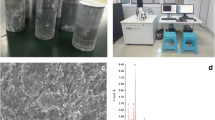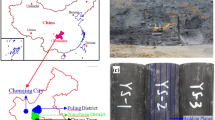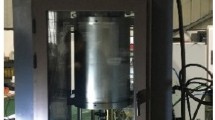Abstract
Uniaxial compressive strength of shale is one of primary input parameters during shale gas development. In order to analyze uniaxial compression failure mechanism and obtain strength formula, the present study regards shale as heterogeneous material composed of pores, brittle minerals and clays. Pores are distributed as oblate ellipsoidal inclusion in clays, while brittle minerals are distributed as spheroidal inclusion in the equivalent clay matrix formed by pores and clays. With the help of the basic solution to Eshelby’s matrix–inclusion problem and the homogenization method, a two-step homogenization framework for shale was established. The influences of pore fluid on the rock mechanical behavior were also discussed by categories. Based on the composite mechanics, the failure strength of shale under uniaxial compression was deduced at last. The results show that the shale strength is affected by the mechanical properties of diagenetic minerals and enhanced with the increase of brittle mineral content. Since pore water promotes the initiation and propagation of cracks, shale strength decreases non-linearly with increasing water saturation.







Similar content being viewed by others
References
Benveniste Y (1987) A new approach to the application of back-stress theory in composite materials. Mech Mater 6(2):147–157
Bieniawski ZT (1974) Estimating the strength of rock materials. J S Afr Inst Min Metall 74(8):312–320
Castañeda PP, Willis JR (1995) The effect of spatial distribution on the effective behavior of composite materials and cracked media. J Mech Phys Solids 43(12):1919–1951
Chen XL (2015) Study on mechanical properties of the shale in West Hubei and East Chongqing. PhD thesis. Southwest University of Science and Technology
Diao HY (2013) Rock mechanical properties and brittleness evaluation of shale reservoir. Acta Petrol Sin 09(01):3300–3306
Dieterich JH, Conrad G (1984) Effect of humidity on time and velocity-dependent friction in rocks. J Geophys Res 89(B6):4196–4202
Dong L, Xiao LZ, Zhang YC (2014) Evaluation model for shale brittleness index based on mineral content and fracture tonghness. Petrol Drill Tech 04(01):37–41
Dunn ML, Wienecke HA (1997) Inclusions and inhomogeneities in transversely isotropic piezoelectric solids. Int J Solids Struct 34(27):3571–3582
Eshelby JD (1957) The determination of the elastic field of an ellipsoidal inclusion, and related problems. Proc R Soc Lond 241(1226):376–396
Fener M, Kahraman S, Bilgil A et al (2005) A comparative evaluation of indirect methods to estimate the compressive strength of rocks. Rock Mech Rock Eng 38(4):329–343
Giraud A, Hoxha D, Do DP et al (2008) Effect of pore shape on effective porothermoelastic properties of isotropic rocks. Int J Solids Struct 45(1):1–23
He S, Wang W, Shen H et al (2015) Factors influencing wellbore stability during underbalanced drilling of horizontal wells—when fluid seepage is considered. J Nat Gas Sci Eng 23:80–89
Hill R (1965) Continuum micro-mechanics of elastoplastic polycrystals. J Mech Phys Solids 13(2):89–101
Hill R (1967) The essential structure of constitutive laws for metal composites and polycrystals. J Mech Phys Solids 15(2):79–95
Hsu S, Nelson PP (2002) Characterization of eagle ford shale. Eng Geol 67:169–183
Levin VM, Markov MG (2005) Elastic properties of inhomogeneous transversely isotropic rocks. Int J Solids Struct 42(2):393–408
Li QH, Chen M, Jin Y (2012) Experimental research on failure modes and mechanical behaviors of gas-bearing shale. Chin J Rock Mech Eng 31(S2):3763–3771
Li Q, Chen M, Zhou Y et al (2013) Rock mechanical properties of shale gas reservoir and their influences on hydraulic fracture. In: IPTC 2013: international petroleum technology conference
Luo C (2013) Study on the structure of hard brittle shale and its effect on mechanical properties. PhD thesis. Southwest Petroleum University
Lutz MP, Zimmerman RW (2005) Effect of an inhomogeneous interphase zone on the bulk modulus and conductivity of a particulate composite. Int J Solids Struct 42(2):429–437
Murphy W, Reischer A, Kai H (2012) Modulus decomposition of compressional and shear velocities in and bodies. Geophysics 58(2):227–239
Nemat N, Hori M (1999) Micromechanics: overall properties of heterogeneous materials, 2nd edn. Elsevier, Amsterdam
Oshita H, Tanabe T (2000) Water migration phenomenon in concrete in postpeak region. J Eng Mech 126(6):573–581
Shi X, Cheng YF, Jiang S et al (2014) Experimental study of microstructure and rock properties of shale samples. Chin J Rock Mech Eng 33(s2):3439–3445
Ulm FJ, Delafargue A, Constantinides G (2005) Experimental microporomechanics. Springer, Berlin
Walpole LJ (1981) Elastic behavior of composite materials: theoretical foundations. In: Yih CS (ed) Advances in applied mechanics, vol 21(01). Elsevier, Amsterdam, pp 169–242
Waruntorn K, Roman V, Hans-Rudolf W et al (2015) Linking preferred orientations to elastic anisotropy in Mudetong shale. Geophysics 80(1):9–19
Wild KM, Wymann LP, Zimmer S et al (2015) Water retention characteristics and state-dependent mechanical and petro-physical properties of a clay shale. Rock Mech Rock Eng 48(2):427–439
Withers PJ (1989) The determination of the elastic field of an ellipsoidal inclusion in a transversely isotropic medium, and its relevance to composite materials. Phil Mag 59(4):759–781
Xie N, Zhu Q, Shao JF et al (2012) Micromechanical analysis of damage in saturated quasi brittle materials. Int J Solids Struct 49(6):919–928
Yin YC, Zhao TB, Tan YL (2015) Reconstruction and numerical test of the mesoscopic model of rock based on Otsu digital image processing. Rock Soil Mech 36(09):2532–2540
Yin S, Ding WL, Sun YX et al (2016) Shale uniaxial compressive failure property and the affecting factors of UCS. Earth Sci Front 23(2):75–95
Zhai Y (2008) Study on dynamic capabilities of rock materials. PhD dissertation thesis. Chang’an University
Zhang J (2013) Borehole stability analysis accounting for anisotropies in drilling to weak bedding planes. Int J Rock Mech Min Sci 60:160–170
Zhu ZD, Hu D (2000) The effect of interstitial water pressure on rock mass strength. Rock Soil Mech 01(01):64–67
Acknowledgements
The research described in this paper was financially supported by the Natural Science Foundation of Jiangsu Province (Grant: BK20141067), and Chongqing Scientific Research Innovation Projects for Postgraduate (Grant: CYB18124).
Author information
Authors and Affiliations
Corresponding author
Additional information
Publisher's Note
Springer Nature remains neutral with regard to jurisdictional claims in published maps and institutional affiliations.
Appendix
Appendix
The object of this research is heterogeneous materials with ellipsoid inclusions, which exhibit transversely isotropic symmetry. Plane \(z_{1} - z_{2}\) refers to the isotropic plane, and z3 refers to the symmetry axis. In order to facilitate the inner product and inversion of tensor, the Walpole’s base is introduced to represent the transversely isotropic fourth-order tensor \({\mathbf{U}}\) (Walpole 1981), which can be expressed as:
The inverse of \({\mathbf{U}}\) can be written as:
where \(l = cd - 2gh\). Similarly, definition of \({\mathbf{U}}^{\prime}\) is \([\begin{array}{cccccc}c^{\prime}& d^{\prime} &e^{\prime} &f^{\prime} &g^{\prime} &h^{\prime}\end{array}]\), and the inner product can be noted in the following symbolic form:
Some standard fourth-order tensors are introduced here:
Therefore, the stiffness tensor of material can be expressed as:
where \(k\) and \(\mu\) represent the bulk and shear moduli, respectively. The Eshelby tensor of ellipsoid inclusion can be written as Walpole’s base:
The corresponding components of Hill polarization tensor for Eshelby tensor \({\mathbf{S}}^{ *}\) can easily read:
where \(D_{pqmn}\) represent the component of stiffness tensor.
Rights and permissions
About this article
Cite this article
Bai, Z., Xu, H., Geng, H. et al. A Study of Uniaxial Compressive Strength of Shale Based on Homogenization Method. Geotech Geol Eng 37, 5485–5497 (2019). https://doi.org/10.1007/s10706-019-00994-y
Received:
Accepted:
Published:
Issue Date:
DOI: https://doi.org/10.1007/s10706-019-00994-y




